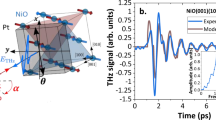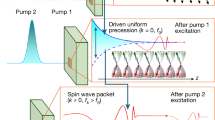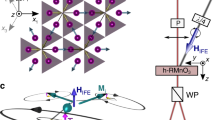Abstract
Non-collinear antiferromagnets, such as Mn3Sn, stand out for their topological properties and potential in antiferromagnetic spintronics. This emerging field aims at harnessing ultrafast magnetization dynamics of antiferromagnets through spin torques. Here we report the time-resolved dynamics of Mn3Sn on a picosecond timescale, driven by an optically induced spin current pulse. Our results reveal that the magnetization of Mn3Sn tilts immediately after the spin current pulse and subsequently undergoes 70 GHz precession. This immediate tilting underscores the predominant role of damping-like torque stemming from spin current absorption by Mn3Sn. We also determine the spin coherence length of Mn3Sn to be approximately 15 nm. This value substantially exceeds that of ferromagnets, highlighting a distinct spin-dephasing process in non-collinear antiferromagnets. Our results hold promise for ultrafast applications of non-collinear antiferromagnets and enrich our understanding of their spin-transfer physics.
This is a preview of subscription content, access via your institution
Access options
Access Nature and 54 other Nature Portfolio journals
Get Nature+, our best-value online-access subscription
$32.99 / 30 days
cancel any time
Subscribe to this journal
Receive 12 print issues and online access
$259.00 per year
only $21.58 per issue
Buy this article
- Purchase on SpringerLink
- Instant access to full article PDF
Prices may be subject to local taxes which are calculated during checkout





Similar content being viewed by others
Data availability
All other data supporting the findings of this study are available from the corresponding authors. Source data are provided with this paper.
References
Jungwirth, T., Marti, X., Wadley, P. & Wunderlich, J. Antiferromagnetic spintronics. Nat. Nanotechnol. 11, 231–241 (2016).
Baltz, V. et al. Antiferromagnetic spintronics. Rev. Mod. Phys. 90, 015005 (2018).
Kimel, A., Kirilyuk, A., Tsvetkov, A., Pisarev, R. & Rasing, T. Laser-induced ultrafast spin reorientation in the antiferromagnet TmFeO3. Nature 429, 850–853 (2004).
Baierl, S. et al. Nonlinear spin control by terahertz-driven anisotropy fields. Nat. Photon. 10, 715–718 (2016).
Kampfrath, T. et al. Coherent terahertz control of antiferromagnetic spin waves. Nat. Photon. 5, 31–34 (2011).
Kimel, A. et al. Ultrafast non-thermal control of magnetization by instantaneous photomagnetic pulses. Nature 435, 655–657 (2005).
Manchon, A. et al. Current-induced spin–orbit torques in ferromagnetic and antiferromagnetic systems. Rev. Mod. Phys. 91, 035004 (2019).
Kang, K., Lee, W.-B., Lee, D.-K., Lee, K.-J. & Choi, G.-M. Magnetization dynamics of antiferromagnetic metals of PtMn and IrMn driven by a pulsed spin-transfer torque. Appl. Phys. Lett. 118, 252407 (2021).
Miwa, S. et al. Giant effective damping of octupole oscillation in an antiferromagnetic Weyl semimetal. Small Sci. 1, 2000062 (2021).
Krén, E., Paitz, J., Zimmer, G. & Zsoldos, É. Study of the magnetic phase transformation in the Mn3Sn phase. Physica B+C 80, 226–230 (1975).
Tomiyoshi, S. & Yamaguchi, Y. Magnetic structure and weak ferromagnetism of Mn3Sn studied by polarized neutron diffraction. J. Phys. Soc. Jpn 51, 2478–2486 (1982).
Brown, P., Nunez, V., Tasset, F., Forsyth, J. & Radhakrishna, P. Determination of the magnetic structure of Mn3Sn using generalized neutron polarization analysis. J. Phys. Condens. Matter 2, 9409 (1990).
Kübler, J. & Felser, C. Non-collinear antiferromagnets and the anomalous Hall effect. Europhys. Lett. 108, 67001 (2014).
Yang, H. et al. Topological Weyl semimetals in the chiral antiferromagnetic materials Mn3Ge and Mn3Sn. New J. Phys. 19, 015008 (2017).
Nakatsuji, S., Kiyohara, N. & Higo, T. Large anomalous Hall effect in a non-collinear antiferromagnet at room temperature. Nature 527, 212–215 (2015).
Ikhlas, M. et al. Large anomalous Nernst effect at room temperature in a chiral antiferromagnet. Nat. Phys. 13, 1085–1090 (2017).
Kimata, M. et al. Magnetic and magnetic inverse spin Hall effects in a non-collinear antiferromagnet. Nature 565, 627–630 (2019).
Hu, S. et al. Efficient perpendicular magnetization switching by a magnetic spin Hall effect in a noncollinear antiferromagnet. Nat. Commun. 13, 4447 (2022).
Higo, T. et al. Large magneto-optical Kerr effect and imaging of magnetic octupole domains in an antiferromagnetic metal. Nat. Photon. 12, 73–78 (2018).
Tsai, H. et al. Electrical manipulation of a topological antiferromagnetic state. Nature 580, 608–613 (2020).
Higo, T. et al. Perpendicular full switching of chiral antiferromagnetic order by current. Nature 607, 474–479 (2022).
Takeuchi, Y. et al. Chiral-spin rotation of non-collinear antiferromagnet by spin–orbit torque. Nat. Mater. 20, 1364–1370 (2021).
Yoon, J.-Y. et al. Handedness anomaly in a non-collinear antiferromagnet under spin–orbit torque. Nat. Mater. 22, 1106–1113 (2023).
Krishnaswamy, G. K. et al. Time-dependent multistate switching of topological antiferromagnetic order in Mn3Sn. Phys. Rev. Appl. 18, 024064 (2022).
Pal, B. et al. Setting of the magnetic structure of chiral kagome antiferromagnets by a seeded spin–orbit torque. Sci. Adv. 8, eabo5930 (2022).
Zhang, S., Levy, P. & Fert, A. Mechanisms of spin-polarized current-driven magnetization switching. Phys. Rev. Lett. 88, 236601 (2002).
Kovalev, A. A., Bauer, G. E. & Brataas, A. Perpendicular spin valves with ultrathin ferromagnetic layers: magnetoelectronic circuit investigation of finite-size effects. Phys. Rev. B 73, 054407 (2006).
Núnez, A. S., Duine, R., Haney, P. & MacDonald, A. Theory of spin torques and giant magnetoresistance in antiferromagnetic metals. Phys. Rev. B 73, 214426 (2006).
MacDonald, A. & Tsoi, M. Antiferromagnetic metal spintronics. Philos. Trans. R. Soc. A 369, 3098–3114 (2011).
Yu, J. et al. Long spin coherence length and bulk-like spin–orbit torque in ferrimagnetic multilayers. Nat. Mater. 18, 29–34 (2019).
Lim, Y. et al. Dephasing of transverse spin current in ferrimagnetic alloys. Phys. Rev. B 103, 024443 (2021).
Stiles, M. D. & Zangwill, A. Anatomy of spin-transfer torque. Phys. Rev. B 66, 014407 (2002).
Choi, G.-M. et al. Optical spin–orbit torque in heavy metal-ferromagnet heterostructures. Nat. Commun. 11, 1482 (2020).
Cheng, Y., Yu, S., Zhu, M., Hwang, J. & Yang, F. Tunable topological Hall effects in noncollinear antiferromagnet Mn3Sn/Pt bilayers. APL Mater. 9, 051121 (2021).
Železný, J., Zhang, Y., Felser, C. & Yan, B. Spin-polarized current in noncollinear antiferromagnets. Phys. Rev. Lett. 119, 187204 (2017).
Yamane, Y., Gomonay, O. & Sinova, J. Dynamics of noncollinear antiferromagnetic textures driven by spin current injection. Phys. Rev. B 100, 054415 (2019).
Shukla, A. & Rakheja, S. Spin-torque-driven terahertz auto-oscillations in noncollinear coplanar antiferromagnets. Phys. Rev. Appl. 17, 034037 (2022).
Okuno, T. et al. Spin-transfer torques for domain wall motion in antiferromagnetically coupled ferrimagnets. Nat. Electron. 2, 389–393 (2019).
Yang, Y. et al. Ultrafast magnetization reversal by picosecond electrical pulses. Sci. Adv. 3, e1603117 (2017).
Jhuria, K. et al. Spin–orbit torque switching of a ferromagnet with picosecond electrical puses. Nat. Electron. 3, 680–686 (2020).
Chen, X. et al. Octupole-driven magnetoresistance in an antiferromagnetic tunnel junction. Nature 613, 490–495 (2023).
Qin, P. et al. Room-temperature magnetoresistance in an all-antiferromagnetic tunnel junction. Nature 613, 485–489 (2023).
Acknowledgements
G.-M.C. was supported by the National Foundation of Korea (2022R1A2C1006504 and RS-2024-00410027). Device fabrication was supported by Advanced Facility Center for Quantum Technology at Sungkyunkwan University. K.-J.L acknowledges financial support from the National Foundation of Korea (2020R1A2C3013302, 2022M3H4A1A04096339 and 2022M3I7A2079267) and Samsung Electronics. B.-G.P. was supported by the National Foundation of Korea (2022R1A4A1031349).
Author information
Authors and Affiliations
Contributions
G.-M.C. and K.-J.L. supervised the study. W.-B.L. fabricated samples and performed the optical measurement and analysis with the help of G.-M.C. and B.-G.P. H.-W.K. and S.H. carried out theoretical calculations for spin coherence length with the help of K.-J.L. W.-B.L., K.-J.L. and G.-M.C. wrote the paper.
Corresponding authors
Ethics declarations
Competing interests
The authors declare no competing interests.
Peer review
Peer review information
Nature Nanotechnology thanks the anonymous reviewers for their contribution to the peer review of this work.
Additional information
Publisher’s note Springer Nature remains neutral with regard to jurisdictional claims in published maps and institutional affiliations.
Extended data
Extended Data Fig. 1 Cross-sectional STEM images and EDS mapping of the samples.
a, b, STEM image of a Pt(5)/Mn3Sn(10), and b Pt(5)/Mn3Sn(20) samples. c, d, EDS mapping image of c Pt(5)/Mn3Sn(10), and d Pt(5)/Mn3Sn(20) samples. The composition ratios of 10 nm, 20nm-thick Mn3Sn samples are Mn3.07Sn0.93, and Mn3.08Sn0.92, respectively.
Extended Data Fig. 2 Roughness measurements of Pt/Mn3Sn samples.
a-c X-ray reflectometry (XRR) scans of a Pt(5)/Mn3Sn(5), b Pt(5)/Mn3Sn(10), and c Pt(5)/Mn3Sn(15) samples. d Roughness of Pt/Mn3Sn samples obtained from the atomic force microscopy (AFM), and XRR scans. AFM data points are represented as mean value ± standard deviation of the five times repeated measurements.
Extended Data Fig. 3 Electrical properties of Pt/Mn3Sn samples.
a, Resistivity R, and b, dR/dT of Pt(5)/Mn3Sn(5), Pt(5)/Mn3Sn(10), and Pt(5)/Mn3Sn(15) samples as a function of temperature T from 6 K to 325 K. These results support that the electrical properties of Mn3Sn do not exhibit a noticeable thickness dependence.
Extended Data Fig. 4 Static longitudinal MOKE measurement of Mn3Sn and Co.
a, Static longitudinal MOKE measurement setup with a lens. The laser is incident parallel to the x-axis but offset by 2 mm from the center of the lens. Then, the laser is focused on the sample with a fixed oblique angle of 20°, determined by the numerical aperture of the lens. b, Static Kerr rotation of Pt/Mn3Sn samples according to the external magnetic field. c,d Static Kerr rotation of c Mn3Sn and d Co as a function of thickness. Data points of c,d are represented as mean value ± standard deviation of the five times repeated measurements.
Supplementary information
Supplementary Information
Supplementary Notes 1–8 and Figs. 1–7.
Source data
Source Data Fig. 1
Source data for Fig. 1c,f.
Source Data Fig. 2
Source data for Fig. 2b,c.
Source Data Fig. 3
Source data for Fig. 3b,c,e,f.
Source Data Fig. 4
Source data for Fig. 4.
Source Data Fig. 5
Source data for Fig. 5a,b.
Source Data Extended Data Fig. 2
Source data for Extended Data Fig. 2.
Source Data Extended Data Fig. 3
Source data for Extended Data Fig. 3.
Source Data Extended Data Fig. 4
Source data for Extended Data Fig. 4b–d.
Rights and permissions
Springer Nature or its licensor (e.g. a society or other partner) holds exclusive rights to this article under a publishing agreement with the author(s) or other rightsholder(s); author self-archiving of the accepted manuscript version of this article is solely governed by the terms of such publishing agreement and applicable law.
About this article
Cite this article
Lee, WB., Hwang, S., Ko, HW. et al. Spin-torque-driven gigahertz magnetization dynamics in the non-collinear antiferromagnet Mn3Sn. Nat. Nanotechnol. 20, 487–493 (2025). https://doi.org/10.1038/s41565-025-01859-7
Received:
Accepted:
Published:
Issue date:
DOI: https://doi.org/10.1038/s41565-025-01859-7



